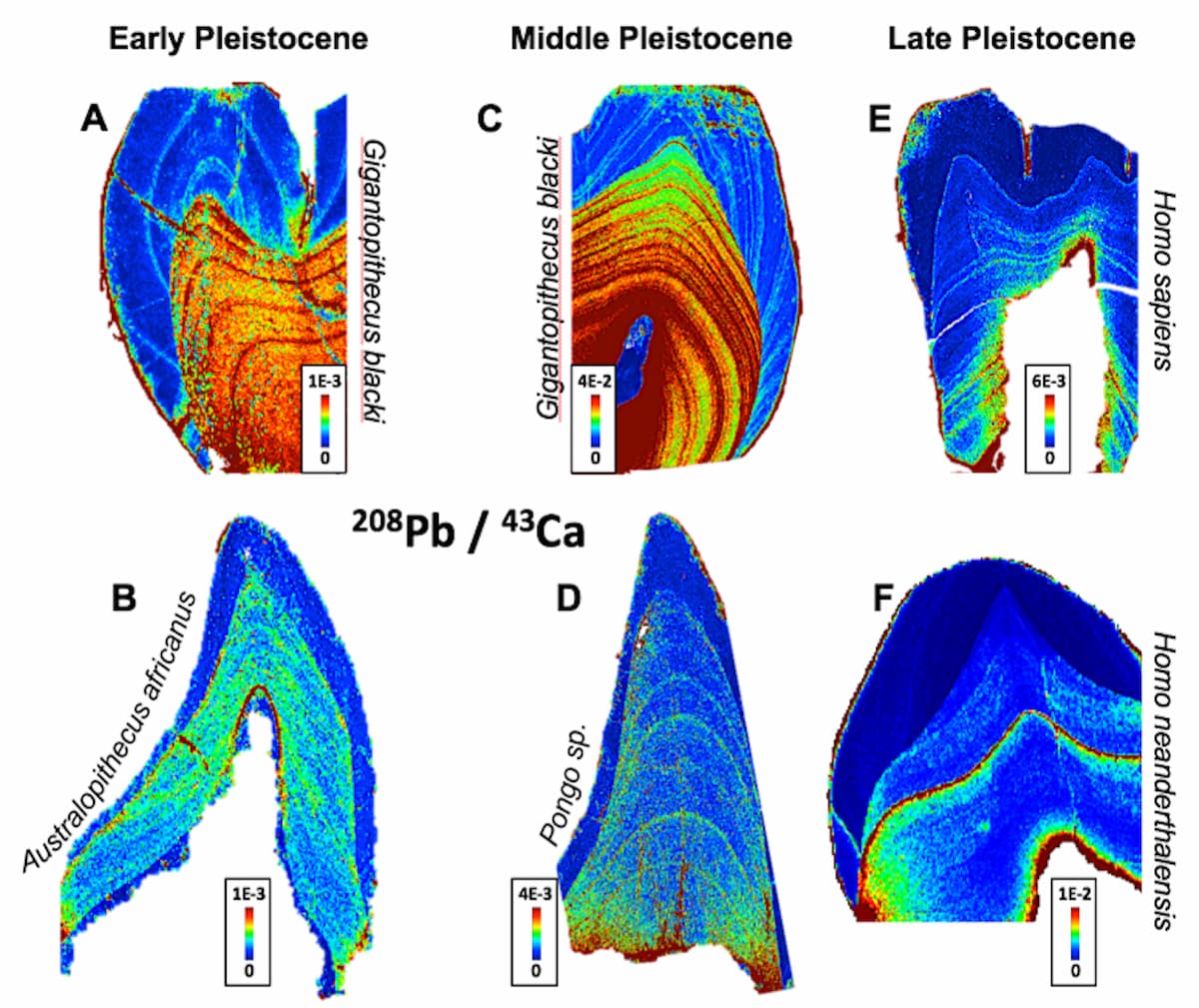Environmental exposure to lead, a phenomenon once believed to be relatively recent in human history, actually dates back more than two million years and affected both modern humans and their extinct relatives, such as the Neanderthals. However, a tiny genetic variation — a single letter in the DNA code — may have acted as a neuroprotective shield in our lineage, enabling the flourishing of complex language and granting us a decisive evolutionary advantage.
This is the main conclusion of an international study led by the University of California, San Diego (UCSD), which analyzes how an omnipresent neurotoxic contaminant may have shaped brain development and, ultimately, the fate of hominid species.
The study, published in Science Advances, is based on the meticulous analysis of fossilized tooth enamel from 51 hominids originating in Africa, Asia, and Europe. The sample includes modern and archaic humans as well as ancient ancestors such as Australopithecus africanus and extinct great apes like Gigantopithecus blacki. The results are striking: 73% of the specimens displayed lead bands in their teeth, a chemical record of exposure during childhood. A particularly significant finding was that fossils of G. blacki, dating back 1.8 million years, showed the most frequent episodes of acute exposure.
 UC San Diego researchers have found high levels of lead in the teeth of both Neanderthals (left) and modern humans (right). However, a gene mutation may have protected modern human brains, allowing language to flourish. Credit: Kyle Dykes/UC San Diego Health Sciences
UC San Diego researchers have found high levels of lead in the teeth of both Neanderthals (left) and modern humans (right). However, a gene mutation may have protected modern human brains, allowing language to flourish. Credit: Kyle Dykes/UC San Diego Health Sciences
We stopped using lead in our daily lives once we understood its toxicity, but no one had ever studied this element in prehistory, explained the study’s corresponding author, Alysson Muotri, Ph.D., professor of Pediatrics and Cellular and Molecular Medicine at UCSD. The historical narrative places the beginning of widespread lead contamination in the era of Roman aqueducts, peaking during the Industrial Revolution.
This research shows that lead poisoning is a much older legacy. In fact, the exposure patterns found in fossil teeth are surprisingly similar to those detected in people born between the 1940s and 1970s, a period when leaded gasoline and lead-based paints were in common use.
The team hypothesizes that the search for basic resources, specifically water, led to these early exposures. One possibility is that these hominids sought caves with running water inside them, Muotri noted. Caves contain lead, so all those spaces were contaminated. According to dental enamel studies, exposure began at a very early stage of childhood.
Because lead is a well-known neurotoxin that harms brain development, causing cognitive deficits and difficulties in emotional regulation, the team faced a crucial question: how could the modern human brain reach such complexity despite this persistent toxic burden?
 Lead banding in fossilized teeth of several hominid species during the Pleistocene. Blue indicates no lead exposure during tooth formation; red indicates high exposure. Credit: UC San Diego Health Sciences
Lead banding in fossilized teeth of several hominid species during the Pleistocene. Blue indicates no lead exposure during tooth formation; red indicates high exposure. Credit: UC San Diego Health Sciences
The answer seems to lie in an almost imperceptible genetic modification. The NOVA1 gene (neuro-oncological ventral antigen 1), considered a master regulator of neurodevelopment, controls how neural progenitor cells respond to lead. Most modern humans possess a variant of NOVA1 that differs by only a single base pair from the archaic version found in Neanderthals.

Subscribe to our newsletter
Receive our news and articles in your email for free. You can also support us with a monthly subscription and receive exclusive content.
Previous research from Muotri’s lab had already shown that replacing the human variant with the archaic one in brain organoids — tiny brain models derived from stem cells — resulted in altered neuronal architecture and less complex long-term synaptic connectivity.
Everything in the organoids is identical except for that genetic variant, which allows us to ask whether that specific mutation gives us any advantage, Muotri said. To test the interaction with lead, the team exposed organoids with both NOVA1 variants to the heavy metal. The results were revealing: while exposure altered NOVA1 expression in both variants, affecting genes linked to disorders such as autism and epilepsy, only the archaic variant modified the expression of the FOXP2 gene. This gene is essential for language and speech development; mutations in FOXP2 prevent the production of sophisticated language.
This type of neuron related to complex language is susceptible to dying in the archaic version of NOVA1 under lead exposure, Muotri explained. The FOXP2 gene is identical between us and Neanderthals, but the way it is regulated by NOVA1 is likely what contributes to linguistic differences. In essence, the modern NOVA1 variant acted as a safety switch, protecting the neural circuits of language from the destructive effects of lead.
The evolutionary implications of this finding are profound. The acquisition of the protective NOVA1 variant may have been a critical event in our history. By safeguarding the capacity for complex language, this genetic shield could have enabled more elaborate social organization, the exchange of ideas, and large-scale group coordination.
Language is such an important advantage; it’s transformative — it’s our superpower, reflected Muotri. Thanks to language, we can organize society and exchange ideas, which allows us to coordinate large movements. There is no evidence that Neanderthals could do that. They might have had abstract thought, but they couldn’t translate it efficiently among themselves. And perhaps the reason is that they never had a communication system as efficient as our complex language.
Muotri speculates that this cognitive disadvantage, exacerbated by omnipresent lead contamination, may have been a contributing — though not exclusive — factor in the extinction of the Neanderthals about 40,000 years ago. While they and other hominids carried the burden of a more vulnerable brain, modern humans, equipped with their protective mutation, were able to thrive.
This research illuminates the relationship between environmental contamination and neurological development, offering new perspectives for understanding human conditions such as speech apraxia or autism, in which language circuits are affected. The study thus reveals how an ancient poison and a small stroke of genetic luck intertwined to write a decisive chapter in the history of humankind.

